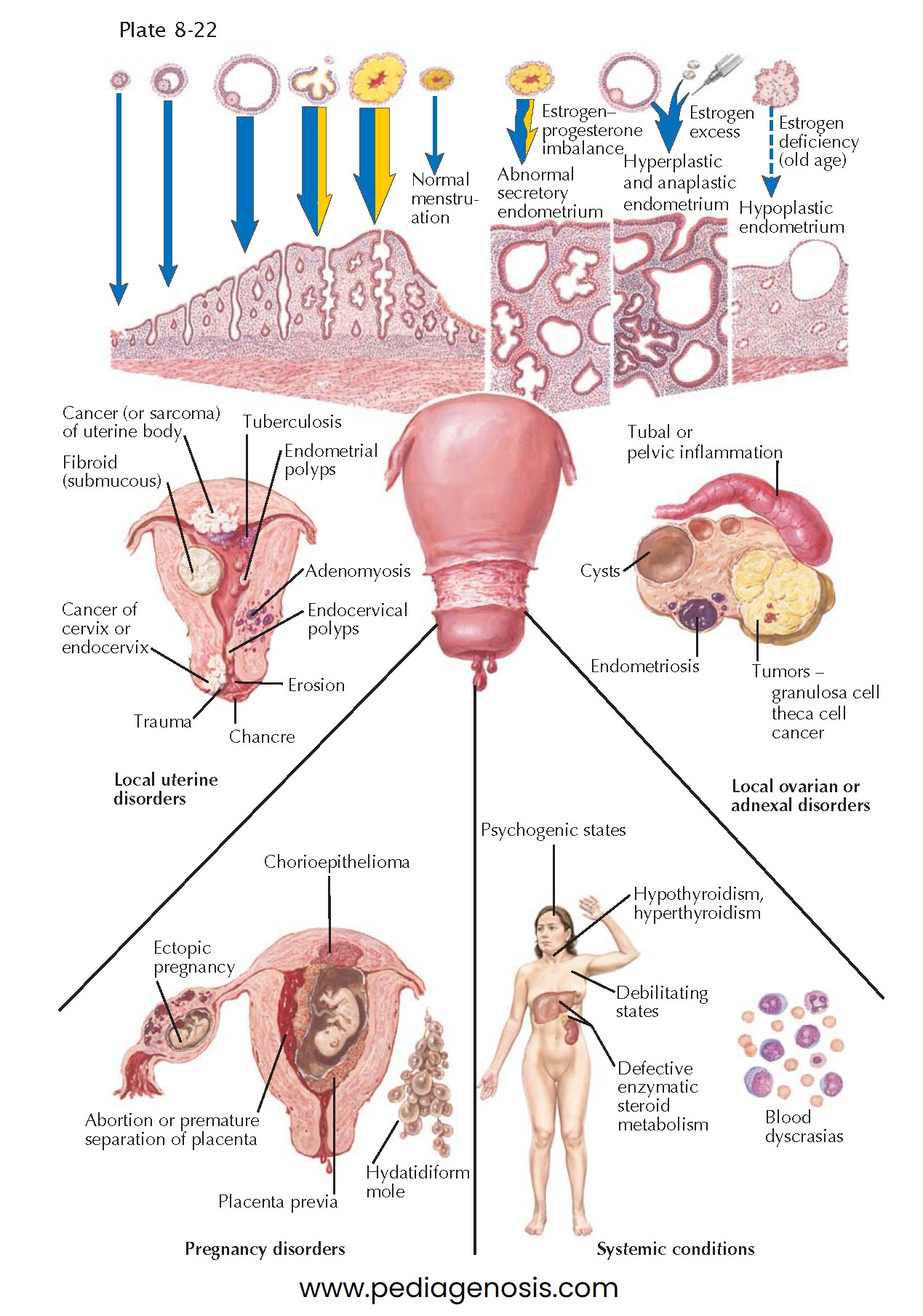CAUSES OF UTERINE BLEEDING
The endometrium is the only tissue in the body in which the regular, periodic occurrence of necrosis and desquamation with bleeding is usually a sign of health rather than of disease. This periodic blood loss is controlled through a delicate balance of pituitary and ovarian hormones and results from the specific response of the target tissue, the endometrium. The normal ebb and flow of estrogen and progesterone, through a monthly cycle, first builds up and then takes away, in regular sequence, the support of the endometrium; therefore, a menstrual flow, characterized by repeated regularity in timing, amount, and duration of bleeding, bears witness to a normal and ordered chain of endocrine events for that individual. Irregularity in any of these characteristics suggests a functional disturbance or organic pathology. The major categories of pathologic states that can cause or be accompanied by either menorrhagia (heavy or prolonged flow) or metrorrhagia (spotting or bleeding between menstrual flows) are discussed below.
In the normal cycle, a progressive increase in estrogen production,
with a sharp rise from the maturing follicle toward the 14th day, causes a
parallel development of all elements in the endometrium—stroma, glands, and
coiled superficial arteries. At or soon after ovulation, the production of
progesterone from the corpus luteum slows growth and proliferation and modifies
the tissue into a secretory pattern. If conception and pregnancy do not occur,
then the corpus luteum regresses in 14 days; its production of both estrogen
and progesterone wanes; there are shrinkage of the endometrium, congestion of
the nutrient arteries, autolysis, necrosis, and desquamation.
Menorrhagia (heavy menstrual flow) is generally divided into primary and
secondary: secondary is caused by (secondary to) some clinically identifiable
cause; primary is caused by a disturbance of prostaglandin production.
Menorrhagia is generally distinguished from acute vaginal bleeding (most often
associated with pregnancy and pregnancy complications). Menorrhagia may result
from an overproduction or an imbalance in the relative ratios of uterine
prostaglandins (prostaglandin E2, prostaglandin I2, and thromboxane A2).
Persistent estrogen without progesterone production, resulting from a
continued failure to ovulate, tends to build up a hyperplastic endometrium in
which nests of anaplastic glands may develop. The circulating level of estrogen
fluctuates in accordance with haphazard spurts of follicle growth. Sporadic
reduction in circulating estrogen, spontaneously or through medication,
undermines the support of the endometrium and initiates the changes inevitably
followed by necrosis and bleeding. In old age, the hypoplastic,
estrogen-deficient endometrium sometimes breaks down and bleeds from a vulnerability
to mild trauma or infection.
Local uterine disorders causing abnormal bleeding include malignancy of
the corpus or cervix, benign submucous fibroids and polyps, adenomyosis, and
infections such as endometritis or tuberculosis. Childbirth lacerations or
erosions are, only rarely, the sole cause for undue bleeding.
Local ovarian or adnexal disorders may involve primary malignancies,
including those cystic or solid ovarian tumors that secrete steroid compounds.
Pelvic inflammatory disease and endometriosis may also cause irregular bleeding.
Pregnancy disorders, due not only to placental dislocations or to
deficiencies as illustrated under systemic conditions, but also to miscarriage,
ectopic gestation, or degenerative conditions such as hydatidiform mole or
chorioepithelioma, constitute the most frequent causes of pregnancy-related
uterine hemorrhage.
A variety of systemic conditions may be responsible for abnormal bleeding. Conditions such as blood dyscrasias, leukemia, and purpura, usually show signs of bleeding elsewhere. Chronic and debilitating disease states, including iron-deficiency anemia and either hypo-or hyperthyroidism, can produce abnormal flow as well as undermine placental function. Defects in steroid metabolism or excretion by the liver or kidneys may produce a buildup in circulating estrogen, with consequent endometrial effects.





